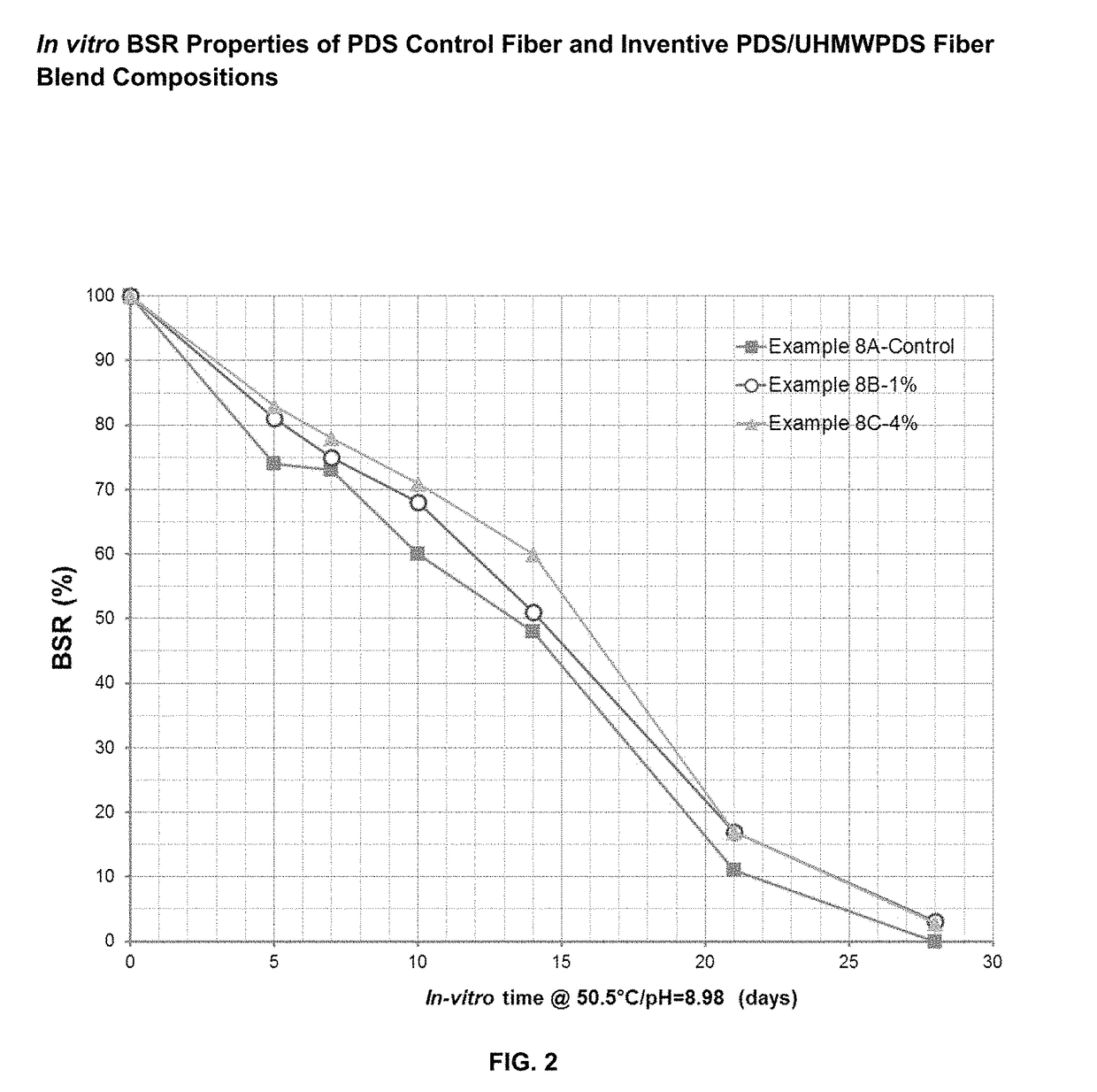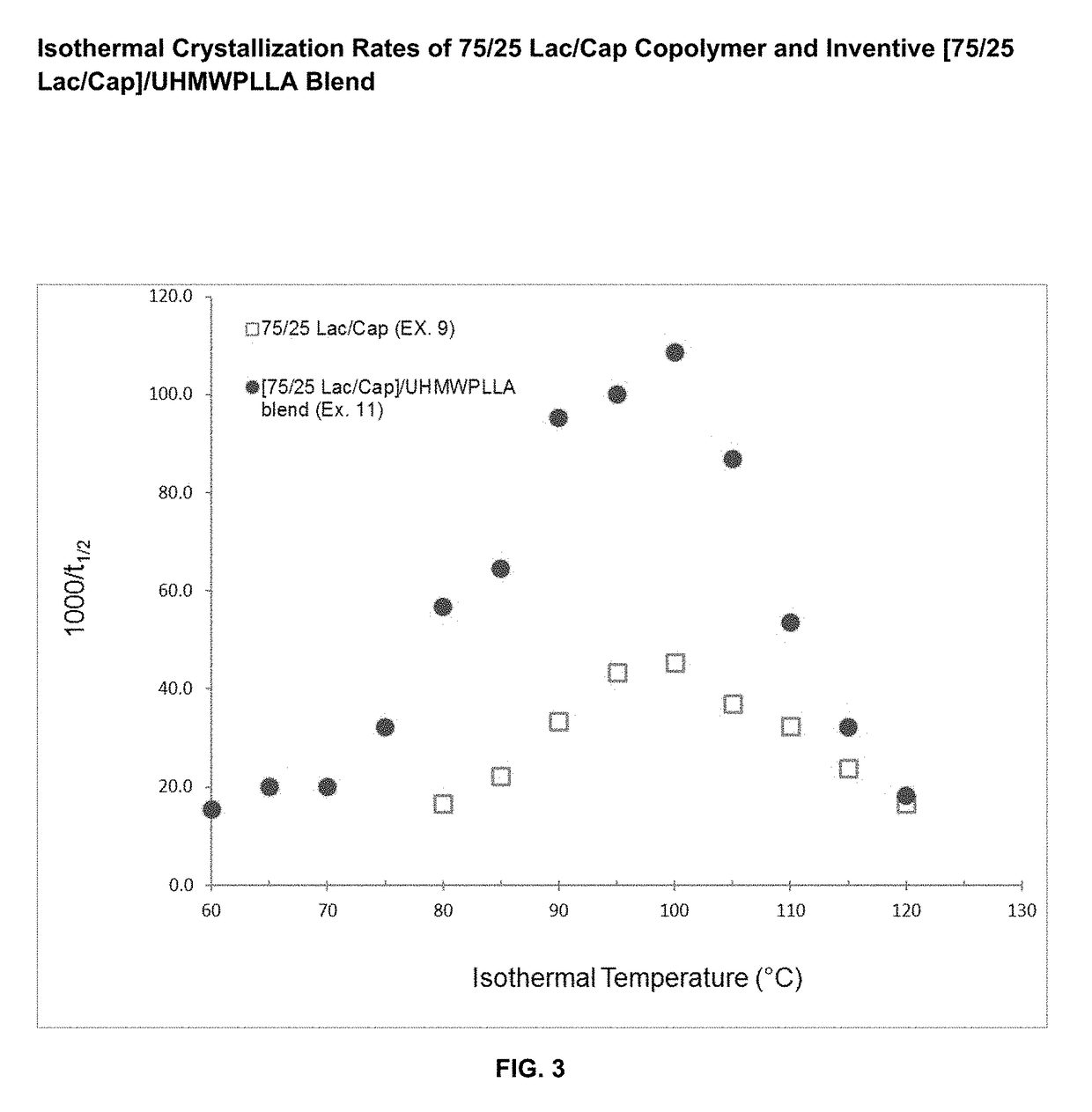Absorbable polymer blend compositions having enhanced nucleation rates
a polymer blend and nucleation rate technology, applied in the field of absorbable polymer blend compositions, can solve the problems of low production capacity, reduced quality of final product, and parts that do not possess the dimensional stability required, and achieve enhanced nucleation mechanism of absorbable materials, enhanced crystallization rate, and higher crystallization kinetics and devices
- Summary
- Abstract
- Description
- Claims
- Application Information
AI Technical Summary
Benefits of technology
Problems solved by technology
Method used
Image
Examples
example 1
Synthesis of Poly(p-Dioxanone): Standard Molecular Weight Polymer (PDS)
[0050]Into a suitable, conventional 65-gallon stainless steel, oil jacketed reactor equipped with agitation, 164.211 kg of p-dioxanone monomer (PDO) was added along with 509 grams of dodecanol, 164 grams of D&C Violet No. 2 Dye, and 100 grams of a 0.33M solution of stannous octoate in toluene. The reactor was closed and a purging cycle, along with agitation at a rotational speed of 12 RPM in an upward direction, was initiated. The reactor was evacuated to pressures less than 500 mTorr followed by the introduction of nitrogen gas. The cycle was repeated several times to ensure a dry atmosphere.
[0051]At the end of the final introduction of nitrogen, the pressure was adjusted to be slightly above one atmosphere. The vessel was heated at a rate of 180° C. per hour until the oil temperature reached approximately 100° C. The oil temperature was held at 100° C. until the batch temperature reached 50° C., at which point ...
example 2
Synthesis of Poly(p-Dioxanone): Ultrahigh Molecular Weight Polymer (UHMWPDS)
[0055]The synthesis step for ultrahigh molecular weight poly(p-dioxanone), UHMWPDS was the same as described in Example 1 except for utilizing a much lower initiator content (monomer to initiator ratio was 5,500:1) and a longer lasting solid state stage.
[0056]The solid state cure was carried on for 14 days at 80° C., followed by grinding, sieving, and a drying procedure. The resulting dried polymer, UHMWPDS had a glass transition temperature of −7.6° C., a melting point of 117° C., and an enthalpy of fusion of 93.2 J / g, as measured by DSC using a heating rate of 10° C. / min. The resin had a weight average molecular weight of 330,000 Daltons as determined by GPC method, and exhibited an inherent viscosity of 5.25 dL / g, as measured in hexafluoroisopropanol at 25° C. at a concentration of 0.10 g / dL. Nuclear magnetic resonance analysis confirmed that the resin was poly(p-dioxanone), with a residual monomer level ...
example 3
Dry Blending of Unimodal PDS Homopolymers
[0057]Appropriate amounts of the dried poly(p-dioxanone) of standard weight average molecular weight (Example 1) and ultrahigh weight average molecular weight component (Example 2), both in divided form (ground), were combined in dry blends. These dry blends were produced on a weight basis, depending on the particular application and surgical need. In the present example, the standard poly(p-dioxanone) resin and UHMWPDS were dry blended as described directly below.
[0058]Into a clean 3-cubic foot Patterson-Kelley dryer specific amounts of the dried resins of Example 1 and Example 2 were added. The dryer was closed, and the vessel pressure was reduced to less than 200 mTorr. The rotation was started at 7.5 RPM and continued for a minimum period of one hour. The dry blend was then discharged into conventional portable vacuum storage containers, and these containers were placed under vacuum, until ready for the melt blending step.
[0059]For the pu...
PUM
| Property | Measurement | Unit |
|---|---|---|
| Temperature | aaaaa | aaaaa |
| Temperature | aaaaa | aaaaa |
| Mass | aaaaa | aaaaa |
Abstract
Description
Claims
Application Information
 Login to View More
Login to View More - R&D
- Intellectual Property
- Life Sciences
- Materials
- Tech Scout
- Unparalleled Data Quality
- Higher Quality Content
- 60% Fewer Hallucinations
Browse by: Latest US Patents, China's latest patents, Technical Efficacy Thesaurus, Application Domain, Technology Topic, Popular Technical Reports.
© 2025 PatSnap. All rights reserved.Legal|Privacy policy|Modern Slavery Act Transparency Statement|Sitemap|About US| Contact US: help@patsnap.com



